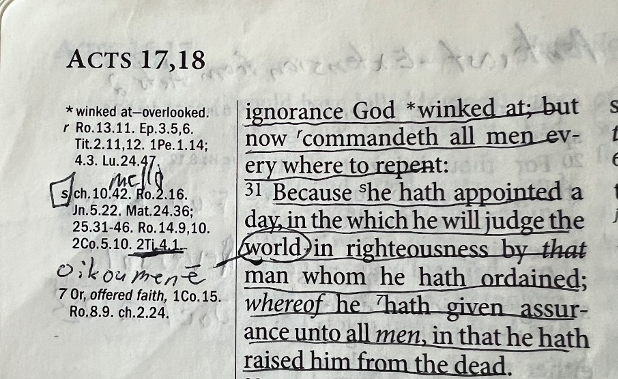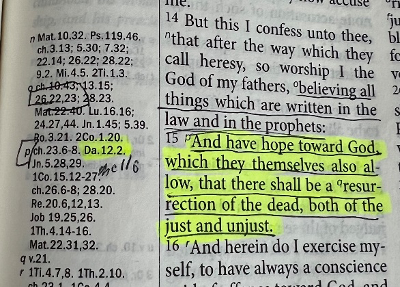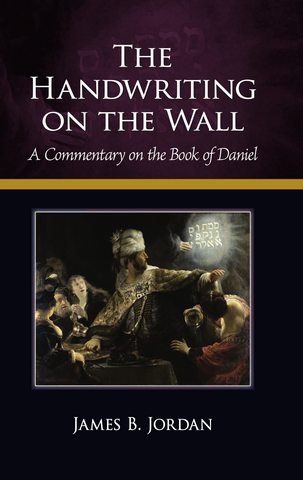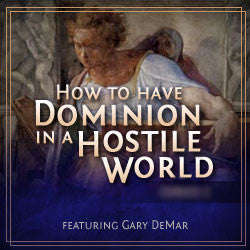Are Reference Bibles Preterist or Futurist?
Important Note: Gary DeMar’s Facebook page has been taken down. To keep up with the latest from Gary and American Vision or to continue the conversation from articles, podcasts, or videos, please go to the AV Facebook page here.
Guest article by Jake Litwin
About the image: “The bar chart that runs along the bottom represents all the chapters in the Bible, starting with Genesis 1 on the left. Books alternate in color between light and dark gray, with the first book of the Old and New Testaments in white. The length of each bar denotes the number of verses in that chapter (for instance, the longest bar is the longest chapter in the Bible, Psalm 119). Each of the 63,779 cross references found in the Bible are depicted by a single arc—the color corresponds to the distance between the two chapters, creating a rainbow-like effect.” — Chris Harrison [1]
My favorite Study Bible is the Westminster Reference Bible. This might be ironic since this Bible is not technically classified as a Study Bible. The WRB has over 200,000 Cross References, making it one of the best tools in letting Scripture interpret Scripture. I consider it my favorite study Bible because it allows the Bible to interpret itself and not rely on study notes. To be clear, the Scripture references are not inspired. They are someone else’s interpretation. The WRB cross references are taken from The Self-Interpreting Bible by John Brown, first published in 1778, as well as the Concord Bible. The WRB struck me with the fascinating cross-references showing what OT passages the NT writers are quoting, as well as similar language and events that multiple NT authors reference.
Let’s take a basic example from Matthew 24:14: “And this gospel of the kingdom shall be preached in all the world (Gk. oikoumenē) for a witness unto all nations; and then shall the end come.” The WRB cross-references Matthew 1:15; 4:23; 28:19; 9:35; Acts 2:5; Rom. 1:8; 10:18; 15:19; Rev. 14:6; Col. 1:6, 23.

What we have is Jesus predicting in the Olivet Discourse before their generation passed away (Matt. 24:34), the Gospel will be preached to the entire known world of that time (Gk. oikoumenē).
Paul confirms that the Gospel did go out into the known world: “But I say, ‘Have they not heard? Yes verily, their sound went into all the earth, and their words unto the ends of the world’ (Gk. oikoumenē).” (Rom. 10:18)
Partial Preterists typically do not have an issue with this connection being a first-century fulfillment, especially because the prediction is before that generation passed away (Matt. 24:34). Where the tension and debates come in with dealing with the timing of the judgment is the timing and nature of the resurrection of the dead. “[B]ecause He did set a day in which He is about to (Gk. mellō) judge the world (Gk. oikoumenē) in righteousness, by a man whom He did ordain, having given assurance to all, having raised him out of the dead.” (Acts 17:31, Young’s Literal Translation/YLT)
The cross references in the WRB for Acts 17:31 are Acts 10:42; Rom. 2:16; John 5:22; Matthew 24:36; 25:31-46; Romans 14:9-10; 2 Corinthians 5:10; 2 Timothy 4:1.

Notice 2 Timothy 4:1 as one of the cross references: “I do fully testify, then, before God, and the Lord Jesus Christ, who is about to (Gk. mellō) judge living and dead at his manifestation and his reign.” (2 Tim. 4:1, YLT)
Another debatable passage with all the different Eschatological positions (Premill, Amill, Postmill, and Full Preterism) is 1 Thessalonians chapter 4. Look at verse 16: “For the Lord Himself shall descend from heaven with a shout, with the voice of the archangel, and with the trump of God: and the dead in Christ shall rise first.”
The WRB references for 1 Thessalonians 4:16 are: Matthew 16:27; 24:30-31; 25:31; 2 Thessalonians 1:7; 1 Corinthians 15:52; Acts 1:11; Ps. 47:5; Revelation 20:11-12; Jude 9.

This is where it gets tricky because Matthew 16:27, 24:30-31, and 2 Thessalonians 1:7 have been defended as referring to a past fulfilment in A.D. 70 by some partial preterists and postmills, but 1 Thessalonians 4 is typically interpreted as being the final judgment by the same partial preterists/postmills. Is the WRB correct in alluding to all these passages being connected with each other? Do we interpret the references as the same events, same language, or both?
One more passage on the same topic about the issue of the resurrection is Acts 24:14-15 cross-referenced with Daniel 12:1-2: “And I confess this to thee, that, according to the way that they call a sect, so serve I the God of the fathers, believing all things that in the law and the prophets have been written, having hope toward God, which they themselves also wait for, [that] there is about to be (Gk. mellō) a rising again of the dead, both of righteous and unrighteous.” (Acts 24:14-15, YLT)
The WRB cross references for Acts 24:14-15 are Acts 23:6-8; Daniel 12:1-2; John 5:28-29; 1 Corinthians 15:12-27; Acts 26:6-8; 28:20; Revelation 20:6, 12-13; Job 19:25-26; 1 Thessalonians 4:14-16; Matthew 22:31-32.

Daniel 12:1-2 is cross-referenced with Acts 24:14-15 along with 1 Thessalonians. 4:14-16.
James B. Jordan on Daniel 12:2 states in his Daniel commentary The Handwriting on the Wall, “the resurrection of verse 2 cannot be the final physical resurrection, but must be a first-century event.”[2]

Unlike “liberal” commentaries, The Handwriting on the Wall takes seriously the claim that Daniel and his contemporaries put this book together. In this respect, this commentary stands within the mainstream of all Jewish and Christian commentaries. But unlike most “conservative” commentaries, the author, James B. Jordan, refuses to jump the prophecies off until the end of time, but takes seriously what they meant for those who heard them.
Ken Gentry on Daniel 12:1-2 agrees, “In Daniel 12:1-2 we find a passage that speaks of the great tribulation in AD 70.”[3] If Jordan and Gentry are correct, then Acts 24:14-15 and 1 Thessalonians 4:14-16 may describe the same event as Daniel 12:1-2, which also takes place in A.D. 70. This would have to include Acts 17:31 and 24:15, 25, and 2 Timothy 4:1.
Do reference Bibles give away the farm to preterism or futurism? The answer ultimately hinges on the hermeneutic we bring to the table. The three specific eschatological systems—historic premillennial, amillennial, and full preterist—can look at the same cross-references and claim victory because they agree on the unity of the events described. What differs is where they place the events in redemptive history. For the futurists, it’s all still ahead. For the full preterists, it was fulfilled in A.D. 70. But the real debate lies deeper than cross references—it lies in the presupposition of the interpretive framework. How do we interpret the time statements? How do we interpret the nature of the resurrection and judgment language?
Can the postmillennialist offer a constructive path forward? Rather than dividing Scripture into strict buckets of Bible passages that are fulfilled in the past and Bible passages that are still in our future, what if we saw these events as interconnected? Many of us are looking at verses as fulfillment as a punctiliar one-and-done event in the past or punctiliar in the future. Could A.D. 70 serve not just as a culmination, but also as a type pointing toward a greater eschatological reality?

While most commentaries on Daniel emphasize a distant future fulfillment, you will learn how this unique prophecy is fulfilled in the four kingdoms described in Daniel 2 and ultimately in the person, life, and work of Jesus Christ. You will also learn the identity of the Little Horn, the timing of the 70 weeks, and practical application for contemporary living.
One presuppositional example: Is it possible that the medieval exegesis of the fourfold senses (the Quadriga) of Scripture plays a role in settling the preterist debate? Peter Leithart states, “According to the medieval theory of the ‘Quadriga’ or the ‘fourfold sense’ of Scripture, each passage of Scripture has four dimensions of meaning. Protestants generally cast a suspicious eye on this ‘method’ of reading. That’s a mistake. It’s a handy guide to the questions we should always ask as we study Scripture.” The four dimensions are: The Literal, Allegorical, Moral, and Anagogical.
He continues,
Patristic and medieval theologians didn’t share this modern embarrassment. On the contrary, all other dimensions of textual meaning grew out of the literal sense. Thomas Aquinas argued that the text referred only to the literal sense, to things, people, and events of the real world. Since God writes with things, events, and words, the things that the text speaks about are signs of other things. If you don’t have a literal sense from the start, you don’t get the other senses either.
“Protestants often want to stop with the literal sense. But that’s equally an error, and leads to boring, truncated readings of Scripture. Medieval theologians knew better. They understood that Scripture speaks literally of things that serve as allegories or types of other things.
Leithart explains how the Quadriga heals our hermeneutics with an example regarding eschatology, “Where eschatologies are underrealized, the Quadriga insists that Christ is already the realization of Israel’s hope; where eschatologies are overrealized, the Quadriga points constantly to glories yet to come.”[4]
If Leithart is correct, then this is the work that needs to be done to prove it in light of the ongoing preterist debates. There might be more light to be found. In the end, the cross-references themselves don’t settle the debate. Until we wrestle seriously with these interpretive principles, we’ll keep talking past one another.
[1] https://www.chrisharrison.net/index.php/visualizations/BibleViz
[2] James B. Jordan, The Handwriting on the Wall, 622.
[3] https://postmillennialworldview.com/2014/11/21/resurrection-in-daniel-122/
[4] https://theopolisinstitute.com/rehabilitating-the-quadriga/
American Vision’s mission is to Restore America to its Biblical Foundation—from Genesis to Revelation. American Vision (AV) has been at the heart of worldview study since 1978, providing resources to exhort Christian families and individuals to live by a Biblically based worldview. Visit www.AmericanVision.org for more information, content and resources
Source: https://americanvision.org/posts/are-reference-bibles-preterist-or-futurist/
Anyone can join.
Anyone can contribute.
Anyone can become informed about their world.
"United We Stand" Click Here To Create Your Personal Citizen Journalist Account Today, Be Sure To Invite Your Friends.
Before It’s News® is a community of individuals who report on what’s going on around them, from all around the world. Anyone can join. Anyone can contribute. Anyone can become informed about their world. "United We Stand" Click Here To Create Your Personal Citizen Journalist Account Today, Be Sure To Invite Your Friends.
LION'S MANE PRODUCT
Try Our Lion’s Mane WHOLE MIND Nootropic Blend 60 Capsules
Mushrooms are having a moment. One fabulous fungus in particular, lion’s mane, may help improve memory, depression and anxiety symptoms. They are also an excellent source of nutrients that show promise as a therapy for dementia, and other neurodegenerative diseases. If you’re living with anxiety or depression, you may be curious about all the therapy options out there — including the natural ones.Our Lion’s Mane WHOLE MIND Nootropic Blend has been formulated to utilize the potency of Lion’s mane but also include the benefits of four other Highly Beneficial Mushrooms. Synergistically, they work together to Build your health through improving cognitive function and immunity regardless of your age. Our Nootropic not only improves your Cognitive Function and Activates your Immune System, but it benefits growth of Essential Gut Flora, further enhancing your Vitality.
Our Formula includes: Lion’s Mane Mushrooms which Increase Brain Power through nerve growth, lessen anxiety, reduce depression, and improve concentration. Its an excellent adaptogen, promotes sleep and improves immunity. Shiitake Mushrooms which Fight cancer cells and infectious disease, boost the immune system, promotes brain function, and serves as a source of B vitamins. Maitake Mushrooms which regulate blood sugar levels of diabetics, reduce hypertension and boosts the immune system. Reishi Mushrooms which Fight inflammation, liver disease, fatigue, tumor growth and cancer. They Improve skin disorders and soothes digestive problems, stomach ulcers and leaky gut syndrome. Chaga Mushrooms which have anti-aging effects, boost immune function, improve stamina and athletic performance, even act as a natural aphrodisiac, fighting diabetes and improving liver function. Try Our Lion’s Mane WHOLE MIND Nootropic Blend 60 Capsules Today. Be 100% Satisfied or Receive a Full Money Back Guarantee. Order Yours Today by Following This Link.






